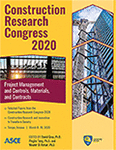Construction Research Congress 2020
Real Options Approach for Flexible Building Delivery
Publication: Construction Research Congress 2020: Project Management and Controls, Materials, and Contracts
ABSTRACT
There is an increasing supply of obsolete buildings across the U.S. that have surpassed their useful life. These buildings become obsolete, either because of aging systems or shifts in market demand for the services and amenities the building provides. As a result, obsolete buildings have a higher cost of ownership and can have a negative effect on occupant productivity and morale. In the manufacturing sector, the rate of building obsolescence is especially high. Because the buildings in this sector are typically customized for a specific product or manufacturing process, they struggle to accommodate change over their lifetime. One solution to this problem is to make the buildings themselves more flexible. This solution requires an understanding of the types of uncertainty facing the project during design, construction, and operation, as well as the potential options that may become available to the owner if modifications to the building are necessary. This paper presents the results of a real options analysis (ROA) to valuate flexible building strategies in the manufacturing sector, where uncertainty is high. Specifically, we consider three strategies—dedicated, general purpose, and scalable—and develop real options for each strategy related to the variable capacity of the project, project life, and timing of project construction or renovation. We demonstrate that certain strategies ultimately offer owners of manufacturing buildings a higher long-term value when considering uncertainty about the future demand of their products. By recognizing this uncertainty and evaluating potential design strategies with ROA, this research provides decision guidance to owners that will increase use of flexible design strategies and reduce instances of building obsolescence.
Get full access to this article
View all available purchase options and get full access to this chapter.
REFERENCES
Cardin, M.-A., Ka-Ho Yue, H., Jiang, Y., Deng, Y., and Santhanakrishnan, D. (2013). Empirical evaluation of flexible design concept generation procedures: A study in emergency services, International Conference on Engineering Design 13.
Cardin, M.-A., Ranjbar-Bourani, M., and de Neufville, R. (2015). Improving the Lifecycle Performance of Engineering Projects with Flexible Strategies: Example of On-Shore LNG Production Design. Systems Engineering, 18(3), 253–268.
Chiara, N., and Garvin, M. J. (2007). Using Real Options for Revenue Risk Mitigation in Transportation Project Financing. Transportation Research Record, 1993(1), 1–8.
Copeland, T. E., and Antikarov, V. (2003). Real Options: A Practitioner's Guide. United Kingdom: Texere.
Gaimon, C., and Singhal, V. (1992). Flexibility and the choice of manufacturing facilities under short product life cycles. European Journal of Operational Research, 60(2), 211–223.
Guj, P., and Chandra, A. (2019). Comparing different real option valuation approaches as applied to a copper mine. Resources Policy, 61, 180–189.
Ford, D. N., Lander, D. M., and Voyer, J. J. (2002). A real options approach to valuing strategic flexibility in uncertain construction projects. Construction Management and Economics, 20(4), 343–351.
Ford, D. N., and Sobek, D. K. (2005). Adapting real options to new product development by modeling the second Toyota paradox. IEEE Transactions on Engineering Management, 52(2), 175–185.
Johnson, A. (1996). Rehabilitation and re-use of existing buildings. Building maintenance and preservation: a guide to design and management. Oxford: Architectural Press, 209–230.
Luehrman, T. A. (1998). Investment Opportunities as Real Options: Getting Started on the Numbers. Harvard Business Review, (July–August 1998). Retrieved from https://hbr.org/1998/07/investment-opportunities-as-real-options-getting-started-on-the-numbers
Mallach, A. (2006). Bringing buildings back: from abandoned properties to community assets: a guidebook for policymakers and practitioners. New Brunswick: National Housing Institute.
Madson, K., Franz, B. (2019). Scenario-Based Flexible Manufacturing Facility Designs: Understanding Lifecycle Value. Engineering Project Organization Conference 2019.
Maslak, K., Franz, B., Molenaar, K., and Kremer, G. (2018). State-of-the-Practice in the Design and Construction of Flexible Facilities. Construction Research Congress 2018.
Mun, J. (2002). Real options analysis: tools and techniques for valuing strategic investments and decisions. Hoboken, NJ: John Wiley and Sons.
National Association of Realtors (2019). Commercial Real Estate Outlook: 2019.Q1. <https://www.nar.realtor/sites/default/files/documents/2019-q1-commercial-real-estate-outlook.pdf>
Iii, J. E. N., & de. Neufville, R. (2001). Hybrid real options valuation of risky product development projects. International Journal of Technology, Policy and Management, 1(1), 29.
Sahinidis, N. V., and Grossmann, I. E. (1990). Multiperiod investment model for processing networks with dedicated and flexible plants. Industrial and Engineering Chemistry Research, 30(6), 1165-1171.
Schwartz, E. S., and Trigeorgis, L. (2001). Real Options and Investment Under Uncertainty. MIT Press.
Seeley, I. H. (1983). Building economics: appraisal and control of building design cost and efficiency. Macmillian Press, 3rd ed.
Slater, S. F. (1993). Competing in high-velocity markets. Industrial Marketing Management, 22(4), 255–263.
Upton, D. M. (1994). The Management of Manufacturing Flexibility. California Management Review, 36(2), 72–89.
Information & Authors
Information
Published In
Construction Research Congress 2020: Project Management and Controls, Materials, and Contracts
Pages: 388 - 397
Editors: David Grau, Ph.D., Arizona State University, Pingbo Tang, Ph.D., Arizona State University, and Mounir El Asmar, Ph.D., Arizona State University
ISBN (Online): 978-0-7844-8288-9
Copyright
© 2020 American Society of Civil Engineers.
History
Published online: Nov 9, 2020
Published in print: Nov 9, 2020
Authors
Metrics & Citations
Metrics
Citations
Download citation
If you have the appropriate software installed, you can download article citation data to the citation manager of your choice. Simply select your manager software from the list below and click Download.
